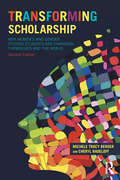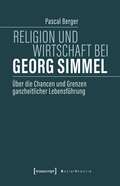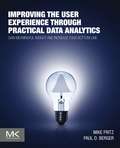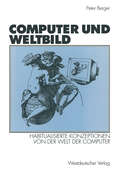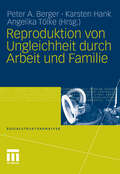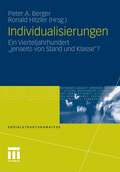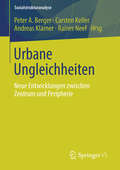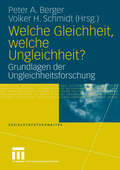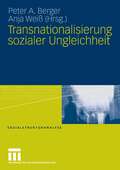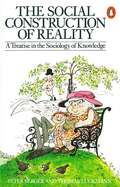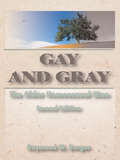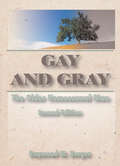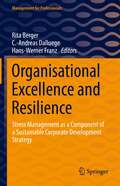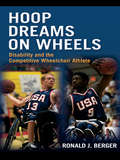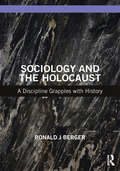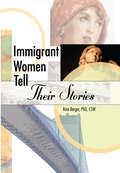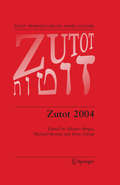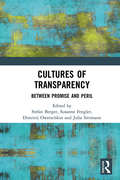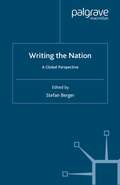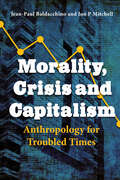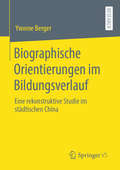- Table View
- List View
Transforming Scholarship: Why Women's and Gender Studies Students Are Changing Themselves and the World
by Michele Tracy Berger Cheryl L RadeloffTransforming Scholarship is a user-friendly work of practical guidance and inspiration for supporting a student's interest in a Women's Studies degree. Berger and Radeloff use empirical evidence to help students with the major barriers they face when exploring Women's Studies: the negative response a student often faces when announcing to the world that he or she is interested in Women’s Studies; and the perceived lack of employment and career options that supposedly comes with graduating with a Women's Studies degree. This book will support students to think critically about what they know, how to demonstrate what they know, and how to prepare for life both personally and professionally after the degree. Transforming Scholarship is a practical guide for students interested in women’s and gender studies that targets advanced undergraduates who have a firm connection to the discipline. This book is ideal for women’s and gender capstone courses, and for those who have finished their degree and need a resource to assist in conceptualizing the answers to the question "What’s next?" This second edition of Transforming Scholarship focuses on areas that undergraduates might want integrate into their women’s and gender studies education: study abroad, civic engagement projects, internships, independent studies, and honors theses. It includes exercises to help flesh out talents, passions, and skills, and how to link them to employment, information about the diversity of employment opportunities (and further professional training) available, and a plan to help prepare for graduation. It also delves into how to live a feminist life after graduation, including activism after college, building and sustaining feminist communities, and feminist parenting. The authors have also added new "Point of View" boxes throughout the book, where scholars focus on contemporary issues and deepen a student’s understanding of the organizations and individuals fighting to end sexist oppression.
Religion und Wirtschaft bei Georg Simmel: Über die Chancen und Grenzen ganzheitlicher Lebensführung (Sozialtheorie)
by Pascal BergerGeorg Simmels Schaffen war von der Frage geleitet, wie eine religiöse Lebensführung unter säkularen Vorzeichen noch möglich ist: Die Geldwirtschaft befreit das Individuum aus traditionalen Bindungen, doch weder die Ökonomie noch die althergebrachten religiösen Institutionen vermögen das noch verbleibende religiöse Begehren nach individueller Ganzheitlichkeit zu befriedigen. Sinnstiftung obliegt, einmal freigesetzt, nun dem auf sich gestellten Individuum selbst. Pascal Bergers Studie zeichnet Simmels Perspektiven auf den Zusammenhang von Religion und Wirtschaft nach und leistet damit einen Beitrag zur soziologischen Theorien- und Ideengeschichte.
Improving the User Experience through Practical Data Analytics: Gain Meaningful Insight and Increase Your Bottom Line
by Paul D. Berger Mike FritzImproving the User Experience through Practical Data Analytics shows you how to make UX design decisions based on data—not hunches. Authors Fritz and Berger help the UX professional recognize the enormous potential of user data that is collected as a natural by-product of routine UX research methods, including moderated usability tests, unmoderated usability tests, surveys, and contextual inquiries. Then, step-by-step, they explain how to utilize both descriptive and predictive statistical techniques to gain meaningful insight with that data. By mastering the use of these techniques, you’ll delight your users, increase your bottom line and gain a powerful competitive advantage for your company—and yourself. Key features include: Practical advise on choosing the right data analysis technique for each project. A step-by-step methodology for applying each technique, including examples and scenarios drawn from the UX field. Detailed screen shots and instructions for performing the techniques using Excel (both for PC and Mac) and SPSS. Clear and concise guidance on interpreting the data output. Exercises to practice the techniquesPractical guidance on choosing the right data analysis technique for each project.Real-world examples to build a theoretical and practical understanding of key concepts from consumer and financial verticals.A step-by-step methodology for applying each predictive technique, including detailed examples.A detailed guide to interpreting the data output and examples of how to effectively present the findings in a report.Exercises to learn the techniques
Computer und Weltbild: Habitualisierte Konzeptionen von der Welt der Computer
by Peter BergerUnser Verhältnis zu Computer und Informationstechnologie wird weniger von den Maschinen bestimmt als davon, wie wir von ihnen denken. Die Informatisierung des Alltags geht einher mit der Entwicklung prägender individueller und kultureller Bilder von der Welt der Computer. In dieser Studie werden erstmals eine umfassende Ethnologie der Computerkultur und eine theoretische und empirische Analyse von Computerweltbildern vorgelegt. Zu diesem Zweck entwickelt der Autor im ersten Teil des Buches ein neues, multiperspektivisches Modell des Weltbildkonzepts. Im zweiten, empirischen Teil analysiert der Autor vor dem Hintergrund einer spezifischen Informatik- und Computerkultur in Gesellschaft, Wissenschaft und Schule die Computerweltbilder von Mathematik- und Informatiklehrern.
Reproduktion von Ungleichheit durch Arbeit und Familie (Sozialstrukturanalyse)
by Peter A. Berger Karsten Hank Angelika TölkeEine wesentliche Erkenntnis der Ungleichheitsforschung bezieht sich darauf, dass bei der Analyse sozialer Ungleichheit nicht das einzelne Individuum, sondern auch der Haushalt und die Familie in den Blick genommen werden müssen. Familien sind mächtige Instanzen lebenslanger intergenerationaler Solidarität. Die sozialen Netzwerke einzelner Familienmitglieder stellen soziales Kapital auch für alle anderen Familienmitglieder dar; Bildung, Einkommen und Status der Eltern sind wesentliche Ressourcen für die Kinder. Diejenigen, die bereits in ihrer Kindheit und Jugend bessere individuelle Startpositionen hatten, sind auch im Erwachsenenalter im Vorteil. Diejenigen, die Kinder haben, verfügen in höherem Alter über Unterstützungsressourcen. All diesen gesellschaftlich erwünschten Transfers, Ressourcen und der Familiensolidarität stehen jedoch – zumindest potenziell – unerwünschte Folgen für die Sozialstruktur, für die Reproduktion und möglicherweise Zunahme gesamtgesellschaftlicher Ungleichheit gegenüber. Der vorliegende Band möchte einen Beitrag zur Klärung zumindest einiger in diesem Zusammenhang relevanter Fragestellungen leisten.
Individualisierungen: Ein Vierteljahrhundert "jenseits von Stand und Klasse"? (Sozialstrukturanalyse)
by Peter A. Berger Ronald HitzlerAuch nach mehr als einem Vierteljahrhundert ist die Diskussion über die von Ulrich Beck in den 1980er Jahren vorgetragene „Individualisierungsthese“ so lebendig wie kontrovers. In theoretischer Hinsicht eröffnet sie immer wieder neue Perspektiven auf (reflexiv) moderne Gesellschaften und provoziert Fragen nach deren Zusammenhalt. Und in empirischer Hinsicht finden sich immer zahlreichere Untersuchungen, die „Individualisierungen“ in verschiedenen Bereichen aufspüren, aber auch Gegenkräfte identifizieren. Dieser Band repräsentiert die Vielzahl und Vielfalt empirischer Analysen und theoretischer Stellungnahmen zu „Individualisierungen“. Mit Beträgen von Soziologinnen und Soziologen unterschiedlicher theoretischer und methodischer Ausrichtungen und aus verschiedenen Generationen öffnet er damit zugleich den Blick auf die Fruchtbarkeit der vor mehr als 25 Jahren entwickelten Individualisierungsthese.
Urbane Ungleichheiten: Neue Entwicklungen zwischen Zentrum und Peripherie (Sozialstrukturanalyse)
by Peter A. Berger Carsten Keller Andreas Klärner Rainer NeefModerne, funktional differenzierte, gleichzeitig aber vertikal stratifizierte Gesellschaften sind urban geprägt. Ihre Ungleichheitsstrukturen haben nicht nur soziale, sondern auch räumliche Dimensionen, die sich in Differenzen innerhalb von Städten, zwischen verschiedenen Städten, aber auch im Verhältnis zwischen Städten und dem ländlich geprägten Raum bzw. zwischen Zentrum und Peripherie ausdrücken. Die Beiträge dieses Bandes bringen zwei Bereiche der Soziologie, die Sozialstrukturanalyse und die Stadt-und Regionalsoziologie, die empirisch oft kooperierten, aber sich seltener über hierfür relevante Konzepte verständigten, in einen Dialog. Die Beiträge beschreiben und analysieren soziale und räumliche Ungleichheiten in städtischen oder ländlichen Lebenswelten und werfen gleichzeitig die Frage auf, wie die aktuelle Gestalt räumlicher Ungleichheiten konturiert und produziert wird.
Welche Gleichheit, welche Ungleichheit?: Grundlagen der Ungleichheitsforschung (Sozialstrukturanalyse #20)
by Peter A. Berger Volker H. SchmidtDer Band widmet sich Fragen danach, welche Gleichheiten in zeitgenössischen Gesellschaften anzustreben, welche Ungleichheiten zu vermeiden sind. Er leistet damit zugleich einen Beitrag zur grundlagentheoretischen Diskussion in der soziologischen Ungleichheitsforschung.
Transnationalisierung sozialer Ungleichheit (Sozialstrukturanalyse)
by Peter A. Berger Anja WeißDie Unterstellung, dass die Grenzen der Gesellschaft und die des Nationalstaats identisch sind, ist vor allem angesichts qualitativ und quantitativ veränderter Migrationsbewegungen in die Kritik geraten. Vor diesem Hintergrund wollen die in diesen Band aufgenommenen Beiträge von Maurizio Bach, Ulrich Beck, Michael Braun, Michael Hartmann, Eleonore Kofman, Bettina Mahlert, Steffen Mau, Jan Mewes, Gerd Nollmann, Ludger Pries, Ettore Recchi, Leslie Sklair, Anton Sterbling und Roland Verwiebe die Grenzen eines „methodologischen Nationalismus“ (U. Beck) sowohl in theoretisch-konzeptioneller wie auch in empirischer Hinsicht überwinden und dabei Antworten auf die Frage geben, was die Sozialstrukturanalyse gewinnt, wenn sie sich für transnationale Perspektiven öffnet.
The Social Construction of Reality: A Treatise in the Sociology of Knowledge (Penguin Social Sciences Ser.)
by Peter L. Berger Thomas LuckmannA general and systematic account of the role of knowledge in society aimed to stimulate both critical discussion and empirical investigations.This book is concerned with the sociology of ‘everything that passes for knowledge in society’. It focuses particularly on that ‘common-sense knowledge’ which constitutes the reality of everyday life for the ordinary member of society.The authors are concerned to present an analysis of knowledge in everyday life in the context of a theory of society as a dialectical process between objective and subjective reality. Their development of a theory of institutions, legitimations and socializations has implications beyond the discipline of sociology, and their ‘humanistic’ approach has considerable relevance for other social scientists, historians, philosophers and anthropologists.
Gay and Gray: The Older Homosexual Man, Second Edition
by Raymond BergerIn the absence of accurate information, American culture has upheld a distorted view of what it means to be an older gay man. Gay and Gray is the first and only scholarly full-length treatment of older gay men in America today. It breaks the stereotype that older gay men are strange, lonely creatures and reveals that most older gay men are well-adjusted to their homosexuality and the aging process.This second edition contains four new chapters that present additional perspectives on the reality of gay aging. Dr. Minnigerode&’s study shows that older gay men do not perceive themselves as growing old faster than their heterosexual counterparts, and that forty is the age at which most gay men believe that the label “young” no longer applies--this finding led Berger and other researchers to define “older” gay men as those over forty. Pope and Schulz confirm Berger&’s finding that for most older gay men a continuation of sexual activity and sexual enjoyment is the norm. John Grube&’s paper on the interaction of older gay men with younger gay liberationists explores the cultural divide between today&’s older gay man and his younger counterpart, filling a gap left in the first edition. And a concluding chapter by Richard Friend on a theory of successful gay aging summarizes much of the current thinking about this topic. The true situation of the older homosexual male presented in Gay and Gray challenges preconceptions about what it means to be old and gay. It asserts that in most ways, older gay men are indistinguishable from other older people. Because the book portrays older gay men in a realistic and sympathetic light, it is therapeutic for the many gay men who have been burdened with society&’s negative and distorted views about them. These men may compare their own lives to those of the respondents described in the book. Gay and Gray offers younger gay men a rare glimpse into their futures and enlightens and comforts those who count older gay men among their family and friends. The conclusions drawn in the book will change people&’s perspectives and offer new ways of thinking for and about older gay men.Gay and Gray is filled with rich case histories and treats its subject with dignity and compassion. Topics of focus include: love relationships social and psychological adjustment gay community self-acceptance being ”in the closet” and ”coming out” as a gay person intergenerational attitudes popular stereotypesAs the first intensive interview and questionnaire study of gay men aged 40 and older in America, Gay and Gray examines the lives of these men in light of cultural stereotypes. Author Berger asks about the social lives of these men, their involvement in both the heterosexual and homosexual communities, their ”coming out” experiences, their attitudes about younger gays, their experiences in growing older, and their strategies for adapting to life&’s challenges. In the study, Berger reveals that, contrary to stereotypic views, most older gay men are well-integrated into social networks and lead active and generally satisfying lives. He found that few live alone; most scored as well as younger gays on measures of psychological adjustment, such as self-acceptance; many are open about their homosexuality with family, friends, and colleagues; and the most well-adjusted older gay men were integrated into a homosexual community, associated with younger gay men, and were unwilling to change their sexual orientation.
Gay and Gray: The Older Homosexual Man, Second Edition
by Raymond BergerIn the absence of accurate information, American culture has upheld a distorted view of what it means to be an older gay man. Gay and Gray is the first and only scholarly full-length treatment of older gay men in America today. It breaks the stereotype that older gay men are strange, lonely creatures and reveals that most older gay men are well-adjusted to their homosexuality and the aging process.This second edition contains four new chapters that present additional perspectives on the reality of gay aging. Dr. Minnigerode&’s study shows that older gay men do not perceive themselves as growing old faster than their heterosexual counterparts, and that forty is the age at which most gay men believe that the label “young” no longer applies--this finding led Berger and other researchers to define “older” gay men as those over forty. Pope and Schulz confirm Berger&’s finding that for most older gay men a continuation of sexual activity and sexual enjoyment is the norm. John Grube&’s paper on the interaction of older gay men with younger gay liberationists explores the cultural divide between today&’s older gay man and his younger counterpart, filling a gap left in the first edition. And a concluding chapter by Richard Friend on a theory of successful gay aging summarizes much of the current thinking about this topic. The true situation of the older homosexual male presented in Gay and Gray challenges preconceptions about what it means to be old and gay. It asserts that in most ways, older gay men are indistinguishable from other older people. Because the book portrays older gay men in a realistic and sympathetic light, it is therapeutic for the many gay men who have been burdened with society&’s negative and distorted views about them. These men may compare their own lives to those of the respondents described in the book. Gay and Gray offers younger gay men a rare glimpse into their futures and enlightens and comforts those who count older gay men among their family and friends. The conclusions drawn in the book will change people&’s perspectives and offer new ways of thinking for and about older gay men.Gay and Gray is filled with rich case histories and treats its subject with dignity and compassion. Topics of focus include: love relationships social and psychological adjustment gay community self-acceptance being ”in the closet” and ”coming out” as a gay person intergenerational attitudes popular stereotypesAs the first intensive interview and questionnaire study of gay men aged 40 and older in America, Gay and Gray examines the lives of these men in light of cultural stereotypes. Author Berger asks about the social lives of these men, their involvement in both the heterosexual and homosexual communities, their ”coming out” experiences, their attitudes about younger gays, their experiences in growing older, and their strategies for adapting to life&’s challenges. In the study, Berger reveals that, contrary to stereotypic views, most older gay men are well-integrated into social networks and lead active and generally satisfying lives. He found that few live alone; most scored as well as younger gays on measures of psychological adjustment, such as self-acceptance; many are open about their homosexuality with family, friends, and colleagues; and the most well-adjusted older gay men were integrated into a homosexual community, associated with younger gay men, and were unwilling to change their sexual orientation.
Organisational Excellence and Resilience: Stress Management as a Component of a Sustainable Corporate Development Strategy (Management for Professionals)
by Rita Berger C. Andreas Dalluege Hans-Werner FranzPersonal stress has an enormous impact on organizational and employee performance. This book introduces the web-based diagnostic tool IMPRESS, which provides employees, managers and HR professionals with information about potential stress factors. The book describes the underlying methodology for this integrated approach and presents the tools and learning modules to support the methodology. A series of case studies from pilot implementations in companies and universities illustrate the application of the approach in a variety of work environments. The book is based on an international research project for a holistic approach to stress prevention by combining Human Systems Audit with the European Excellence approach as promoted by the Common Assessment Framework (CAF) and the EFQM Excellence Model. This approach is intended to contribute to organizational development that supports effective employee stress management.
Hoop Dreams on Wheels: Disability and the Competitive Wheelchair Athlete (Sociology Re-Wired)
by Ronald BergerHoop Dreams on Wheels is a life-history study of wheelchair athletes associated with a premier collegiate wheelchair basketball program. The book, which grapples with the intersection of biography and history in society, situates the study in broader context with background on the history and sociology of disability and disability sports. It documents the development and evolution of the basketball program and tells the individual life stories of the athletes, highlighting the formative interpersonal and institutional experiences that influenced their agentive actions and that helped them achieve success in wheelchair sports. It also examines divisions within the disability community that reveal both empowering and disempowering aspects of competitive wheelchair athletics, and it explores some of the complexities and dilemmas of disability identity in contemporary society. The book is intended to be read by a general audience as well as by students in college courses on disability, sports, social problems, deviance, medical sociology and anthropology, and introductory sociology. It also will be of interest to scholars in the sociology of disability, sociology of sports, and medical humanities, as well as life-history researchers and professionals in the fields of physical education, therapeutic recreation, and rehabilitative counseling.
Hoop Dreams on Wheels: Disability and the Competitive Wheelchair Athlete (Sociology Re-Wired)
by Ronald BergerHoop Dreams on Wheels is a life-history study of wheelchair athletes associated with a premier collegiate wheelchair basketball program. The book, which grapples with the intersection of biography and history in society, situates the study in broader context with background on the history and sociology of disability and disability sports. It documents the development and evolution of the basketball program and tells the individual life stories of the athletes, highlighting the formative interpersonal and institutional experiences that influenced their agentive actions and that helped them achieve success in wheelchair sports. It also examines divisions within the disability community that reveal both empowering and disempowering aspects of competitive wheelchair athletics, and it explores some of the complexities and dilemmas of disability identity in contemporary society. The book is intended to be read by a general audience as well as by students in college courses on disability, sports, social problems, deviance, medical sociology and anthropology, and introductory sociology. It also will be of interest to scholars in the sociology of disability, sociology of sports, and medical humanities, as well as life-history researchers and professionals in the fields of physical education, therapeutic recreation, and rehabilitative counseling.
Sociology and the Holocaust: A Discipline Grapples with History
by Ronald J BergerFor some time the conventional wisdom in the interdisciplinary field of Holocaust studies is that sociologists have neglected this subject matter, but this is not really the case. In fact, there has been substantial sociological work on the Holocaust, although this scholarship has often been ignored or neglected including in the discipline of sociology itself. Sociology and the Holocaust brings this scholarly tradition to light, and in doing so offers a comprehensive synthesis of the vast historical and social science literature on the before, during, and after of the Holocaust—a tour d’horizon from an explicitly sociological perspective. As such, the aim of the book is not simply to describe the chronology of events that culminated in the deaths of 6 million Jews but to draw upon sociology’s “theoretical toolkit” to understand these events and the ongoing legacy of the Holocaust sociologically.
Sociology and the Holocaust: A Discipline Grapples with History
by Ronald J BergerFor some time the conventional wisdom in the interdisciplinary field of Holocaust studies is that sociologists have neglected this subject matter, but this is not really the case. In fact, there has been substantial sociological work on the Holocaust, although this scholarship has often been ignored or neglected including in the discipline of sociology itself. Sociology and the Holocaust brings this scholarly tradition to light, and in doing so offers a comprehensive synthesis of the vast historical and social science literature on the before, during, and after of the Holocaust—a tour d’horizon from an explicitly sociological perspective. As such, the aim of the book is not simply to describe the chronology of events that culminated in the deaths of 6 million Jews but to draw upon sociology’s “theoretical toolkit” to understand these events and the ongoing legacy of the Holocaust sociologically.
Immigrant Women Tell Their Stories
by Roni Berger"I felt like an alien who fell down to earth, not understanding the rules of the game, making all the possible mistakes, saying all the wrong things." "Your whole life is in the hands of other people who do not always mean well and there is nothing you can do about it. They can decide to send you away and you have no control." "The moment I enter the house, I shelve my American self and become the 'little obedient wife' that my husband wants me to be." "The most difficult part is to find myself again. At the beginning I lost myself." This jargon-free book documents and analyzes the experience of immigration from the female perspective. It discusses the unique challenges that women face, offers insights into the meanings of their experiences, develops gender-sensitive knowledge about immigration, and discusses implications for the effective development and provision of services to immigrant women. With fascinating case studies of immigration to the United States, Australia, and Israel as well as helpful lists of relevant organizations and Web site/Internet addresses, Immigrant Women Tell Their Stories is for everyone who wants to learn or teach about immigration, especially its female face. "It was like somebody sawed my heart in two. One part remained in Cuba and one part here." Immigrant Women Tell Their Stories examines the nature of immigration for women through the eyes of those who have experienced it: how they perceive, interpret, and address the nature of the experience, its multiple aspects, the issues that it presents, and the strategies that immigrant women develop to cope with those issues. The women in this extraordinary book came from different spots around the globe, speak different languages and dialects, and their English comes in different accents. They vary in age as well as in cultural, ethnic, social, educational, and professional status. They represent a rainbow of family types and political opinions. In spite of their diversity, all these women share immigration experience. This book provides an understanding of the journeys they traveled and the experiences they lived to bring you new insights into what it means to immigrate as a woman and to frame effective strategies for working with-and for-immigrant women. "My father is the head of the house. When he decided to move to America [from India] my mother and us, the daughters, did not have much say. My mother and I were not happy at all, but it did not matter." Immigrant Women Tell Their Stories provides you with historical and global perspectives on immigration and addresses: legal, political, economic, social, and psychological dimensions of immigration and its aftermath deconstructing immigration by age, gender, and circumstances major issues of immigrant women-language, mothering, relationships and marriage, finding employment, assimilation (how much and how soon), loneliness, and more resilience in immigrant women immigration from a lesbian perspective guidelines for the development and delivery of services to immigrant women "You may say that I am the bridge, the desert generation that lost the chance to have it my way. But I will do my best to raise my daughters to have more choices than I." In this well-referenced book, immigrant women from Austria, Bosnia, Cuba, various parts of the former Soviet Union, Guatemala, India, Israel, Lebanon, Mexico, Pakistan, and the Philippines tell us their stories, recount what their experiences entailed and what challenges they posed, and teach us ways to help them cope successfully. "This was the best decision we could have made and the best thing we had ever done."
Immigrant Women Tell Their Stories
by Roni Berger"I felt like an alien who fell down to earth, not understanding the rules of the game, making all the possible mistakes, saying all the wrong things." "Your whole life is in the hands of other people who do not always mean well and there is nothing you can do about it. They can decide to send you away and you have no control." "The moment I enter the house, I shelve my American self and become the 'little obedient wife' that my husband wants me to be." "The most difficult part is to find myself again. At the beginning I lost myself." This jargon-free book documents and analyzes the experience of immigration from the female perspective. It discusses the unique challenges that women face, offers insights into the meanings of their experiences, develops gender-sensitive knowledge about immigration, and discusses implications for the effective development and provision of services to immigrant women. With fascinating case studies of immigration to the United States, Australia, and Israel as well as helpful lists of relevant organizations and Web site/Internet addresses, Immigrant Women Tell Their Stories is for everyone who wants to learn or teach about immigration, especially its female face. "It was like somebody sawed my heart in two. One part remained in Cuba and one part here." Immigrant Women Tell Their Stories examines the nature of immigration for women through the eyes of those who have experienced it: how they perceive, interpret, and address the nature of the experience, its multiple aspects, the issues that it presents, and the strategies that immigrant women develop to cope with those issues. The women in this extraordinary book came from different spots around the globe, speak different languages and dialects, and their English comes in different accents. They vary in age as well as in cultural, ethnic, social, educational, and professional status. They represent a rainbow of family types and political opinions. In spite of their diversity, all these women share immigration experience. This book provides an understanding of the journeys they traveled and the experiences they lived to bring you new insights into what it means to immigrate as a woman and to frame effective strategies for working with-and for-immigrant women. "My father is the head of the house. When he decided to move to America [from India] my mother and us, the daughters, did not have much say. My mother and I were not happy at all, but it did not matter." Immigrant Women Tell Their Stories provides you with historical and global perspectives on immigration and addresses: legal, political, economic, social, and psychological dimensions of immigration and its aftermath deconstructing immigration by age, gender, and circumstances major issues of immigrant women-language, mothering, relationships and marriage, finding employment, assimilation (how much and how soon), loneliness, and more resilience in immigrant women immigration from a lesbian perspective guidelines for the development and delivery of services to immigrant women "You may say that I am the bridge, the desert generation that lost the chance to have it my way. But I will do my best to raise my daughters to have more choices than I." In this well-referenced book, immigrant women from Austria, Bosnia, Cuba, various parts of the former Soviet Union, Guatemala, India, Israel, Lebanon, Mexico, Pakistan, and the Philippines tell us their stories, recount what their experiences entailed and what challenges they posed, and teach us ways to help them cope successfully. "This was the best decision we could have made and the best thing we had ever done."
Zutot 2004 (Zutot: Perspectives on Jewish Culture #4)
by Shlomo Berger M. Brocke I. E. ZwiepThe yearbook Zutot serves as a platform for small but incisive contributions on Jewish Studies. It covers Jewish Culture in its broadest sense, encompassing various academic disciplines such as literature, languages and linguistics, philosophy, art, sociology, politics, and history. It also reflects binary oppositions such as religious and secular, high and low, written and oral, male and female culture.
Cultures of Transparency: Between Promise and Peril
by Stefan BergerThis volume addresses the major questions surrounding a concept that has become ubiquitous in the media and in civil society as well as in political and economic discourses in recent years, and which is demanded with increasing frequency: transparency. How can society deal with increasing and often diverging demands and expectations of transparency? What role can different political and civil society actors play in processes of producing, or preventing, transparency? Where are the limits of transparency and how are these boundaries negotiated? What is the relationship of transparency to processes of social change, as well as systems of social surveillance and control? Engaging with transparency as an interrelated product of law, politics, economics and culture, this interdisciplinary volume explores the ambiguities and contradictions, as well as the social and political dilemmas, that the age of transparency has unleashed. As such it will appeal to researchers across the social sciences and humanities with interests in politics, history, sociology, civil society, citizenship, public policy, criminology and law.
Writing the Nation: A Global Perspective
by Stefan BergerThis book brings together experts on national history writing from all five continents to discuss the role of history in the making of national identities in a transnational and comparative way. The institutionalization and professionalisation of history writing is analysed in the context of history's increasing nationalization.
Cultures of Transparency: Between Promise and Peril
by Stefan Berger Susanne Fengler Dimitrij Owetschkin Julia SittmannThis volume addresses the major questions surrounding a concept that has become ubiquitous in the media and in civil society as well as in political and economic discourses in recent years, and which is demanded with increasing frequency: transparency. How can society deal with increasing and often diverging demands and expectations of transparency? What role can different political and civil society actors play in processes of producing, or preventing, transparency? Where are the limits of transparency and how are these boundaries negotiated? What is the relationship of transparency to processes of social change, as well as systems of social surveillance and control? Engaging with transparency as an interrelated product of law, politics, economics and culture, this interdisciplinary volume explores the ambiguities and contradictions, as well as the social and political dilemmas, that the age of transparency has unleashed. As such it will appeal to researchers across the social sciences and humanities with interests in politics, history, sociology, civil society, citizenship, public policy, criminology and law.
Morality, Crisis and Capitalism: Émigré Scholars and the Production of Historical Knowledge in the 20th Century
by Stefan Berger Philipp MüllerAs a pioneering volume to consider the impact of exile on historical scholarship in the twentieth century in a systematic and global way, looking at Europe, North America, South America and Asia, Dynamics of Emigration asks about epistemic repercussions on the experience of exile and exiles. Analyzing both the impact that exile scholars had on their host societies and on the societies they had to leave, the volume investigates exiles’ pathways to integration into new host societies and the many difficulties they face establishing themselves in new surroundings. Focusing on the age of extremes and the realms of exile from fascist and right-wing dictatorships as well as communist regimes, the contributions look at the reasons scholars have for going into exile while providing side-by-side examination of the support organizations and paths for success involved with living in exile.
Biographische Orientierungen im Bildungsverlauf: Eine rekonstruktive Studie im städtischen China
by Yvonne BergerYvonne Berger untersucht in einer rekonstruktiven Studie die sozialen und räumlichen Bedingungen universitärer Bildungsverläufe im städtischen China. Dabei fokussiert sie eine bislang qualitativ-empirisch wenig beforschte Gruppe, die sogenannten Bildungsaufsteigerinnen und -aufsteiger im Kontext des chinesischen Bildungssystems. Auf der Basis narrativ-biographischer Interviews widmet sich die Autorin insbesondere den biographischen Orientierungen junger Chinesinnen und Chinesen, indem sie die Bildungsstrategien sowie Aneignungs- und Reflexionsprozesse über die Phasen und Bildungsübergänge im Lebensverlauf empirisch in den Blick nimmt.
